Celosia Flower: Cockscomb Flower Care (Celosia Plant Growing Guide)
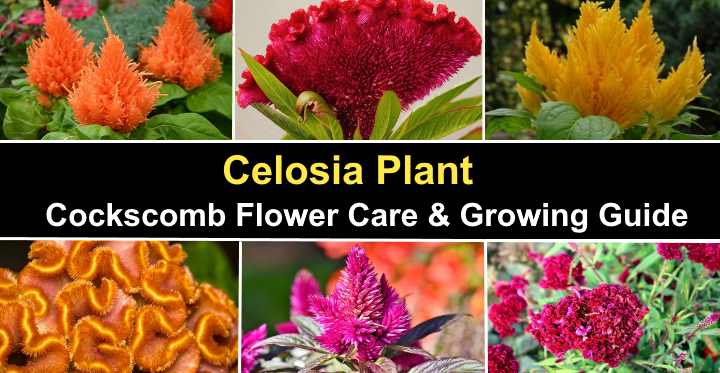
Cockscomb flowers (Celosia) are some of the most spectacular and unusual flowers you will see growing on a plant. There are three types of celosia flowers—Celosia spicata with colorful spikes of feathery flowers, Celosia argentea that has vibrant flowers in a plume shape, and Celosia cristata with flowers that resemble a rooster’s comb. Celosia plants are easy to grow if you live in warm climates.
Celosia flowering plants thrive outdoors in tropical regions. The stunning flowers on celosia plants appear in spring and summer. The long-blooming flowers fill garden landscapes with colors such as bright red, fiery orange, golden yellows, and magenta pink.
Celosia is a genus of small flowering bushy plants in the family Amaranthaceae. Varieties of celosia range in size from 6” (15 cm) tall to over 3 ft. (1 m). Celosia plants are popular plants to start from seed because they are so easy to grow.
This article is a complete care guide to growing cockscomb flowers in your garden. You will also find out about some varieties of extraordinary celosia flowers for growing in your front or backyard.
Celosia Plant Care – Overview
To care for celosia plants, grow the tropical plants in full sun to get eight hours of sunlight daily. Plant celosia flowers in well-draining, fertile soil that retains moisture. Water cockscomb plants three or four times weekly during spring and summer. The minimum growing temperature for celosia plants is 60°F (15°C).
Celosia flowers are also ideal plants for containers in your yard or indoors as a houseplant.
To grow celosia plants in pots, use a well-draining potting mix with plenty of organic material. Place the flowering potted celosia plant in a sunny location. Water often enough to keep the soil moist but not soggy. Growing temperatures indoors are between 70°F and 80°F (21°C – 27°C).
Is Celosia Annual or Perennial?
Celosia is a group of bushy ornamental plants that grow as hardy perennials in USDA zones 10 through 11. In zones 4 through 9, you can grow varieties of celosia as tender annuals. You can plant seeds indoors in springtime and transfer the brightly-colored plants outside when the temperature is between 60°F and 65°F (15°C – 18°C).
Celosia Flower (Cockscomb Flower)
Celosia flowers are the most attractive feature of this tender tropical plant. When they start blooming in mid-spring, celosia flowers continue blooming for between eight and ten weeks. Their long blooming season means you can enjoy a stunning display of vivid colors all summer long.
Celosia flowers are small showy flowers that grow in dense clusters. Some celosia varieties have long-lasting plumes of feathery flowers that grow as colorful spikes. The cockscomb flowers are twisted plumes that resemble a rooster’s comb—hence the name cockscomb. And other celosia flowers are small, spiked wheat-like heads.
Types of Flowering Celosia Plants
There are three main types of celosia plants. Varieties of celosia plants are divided into groups depending on the kind of flowers they produce. Here are the three varieties of celosia:
Celosia cristata—The cockscomb celosia has a flowerhead made up of twisted plumage. This crested type of celosia flower blooms in colors such as white, pink, yellow, red, and orange.
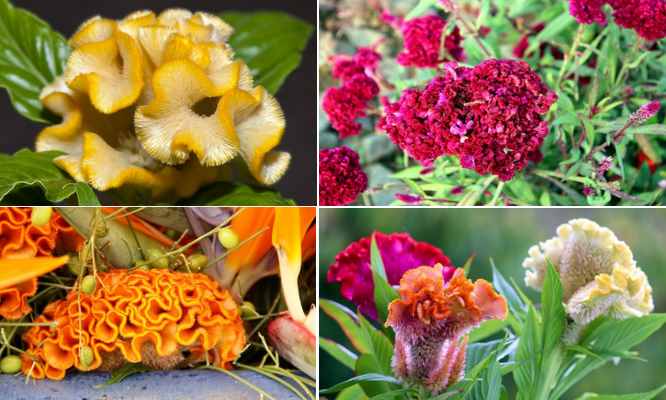
Celosia cristata flowers
Celosia spicata—The wheat type of celosia flower has colorful spiked flower heads that look like a small bottle brush or head of wheat. This spiked celosia doesn’t have as vibrant colors as the other celosia plants.
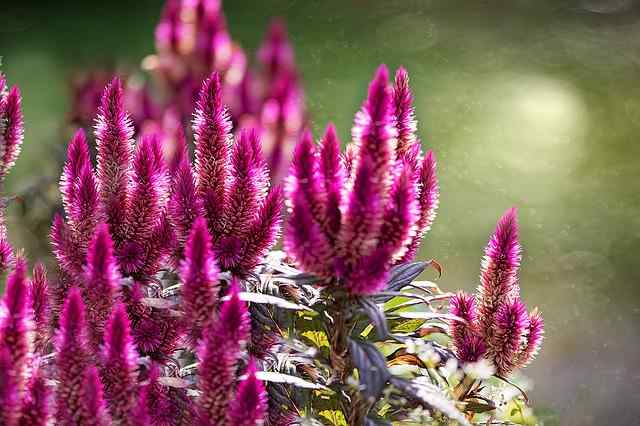
Celosia spicata
Celosia argentea—Also called Celosia plumosa, the feather plumes of this celosia flower look like brightly-colored arrowheads. Each celosia plant produces multitudes of flower clusters, giving the plant a dramatic appearance.
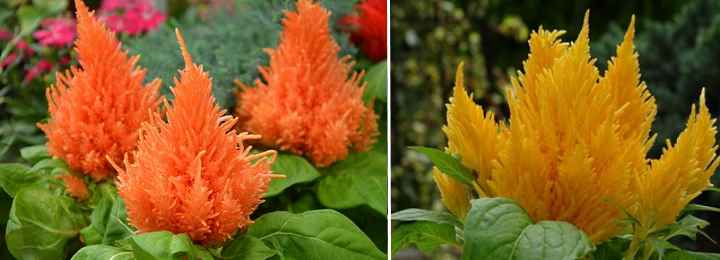
Celosia argentea
About Celosia Seeds
Celosia plants produce plenty of seeds, and this is the primary way of propagation. The seeds from cockscomb flowers are tiny and will quickly germinate when the temperature warms up. You can either collect seeds from spent celosia flowers or buy packets of mixed seeds for replanting the following year.
Does Celosia Reseed Itself?
Cockscomb plants typically reseed themselves every year when growing in zones 10 and 11. Although cockscomb is an annual in other colder zones, the seeds disperse easily and rapidly. In some countries, the self-seeding nature of celosia means that the plant is classed as an invasive weed.
How Long Does It Take for Celosia Seeds to Germinate?
Celosia seeds germinate when the temperature is between 70°F and 75°F (21°C – 24°C). It takes between eight and fourteen days for seeds to sprout. The best way to germinate the seeds is to sow directly on the soil and cover with a light layer of soil.
For seeds to germinate successfully, they must be in full sun, warm temperatures, and moist soil. Mist the soil regularly to encourage germination.
You can start celosia seeds outdoors if you live in zones 10 and 11. It takes about four months for celosia flowers to appear on mature plants.
If you live in colder climates, start celosia seeds indoors between six and eight weeks before the last frost. When the risk of frost has passed, you can transfer the plants outdoors to plant in a sunny location.
How to Deadhead Celosia Flowers
Cockscomb flowers have a long blooming time—up to four weeks. Deadhead spent flowers by snipping off plumes when half of their color has faded from the bottom. Deadheading celosia flowers encourages more blooms and fewer seeds.
How Long Do Celosia Plants Last?
Celosia flowers last for up to ten weeks and can continue blooming until the first frost if you deadhead them. Flowers from cockscomb plants are also excellent cut flowers for floral displays. Cut celosia flowers last for up to four weeks in a vase of water.
If you live in colder climates, you can bring potted celosia plants indoors to make their flowers last for a few more weeks.
How to Care for Celosia Plants
Cockscomb plants are easy to care for if they get enough sunshine, grow in warm temperatures, and are watered regularly. In USDA zones 10 and 11, celosia flowers may reseed every year, and you don’t need to replant them. In temperate climates that have cold winters, you care for celosia plants as annuals.
Let’s look in more detail at how to care for cockscomb plants.
Where to Plant Cockscomb Flowers
Celosia plants need between six and eight hours of direct sunshine daily. Plant cockscomb flowers in the sunniest part of your garden. The beautiful flowers will continue to bloom if there is some partial afternoon shade. A lack of sunlight is a common reason why cockscomb flowers wilt and die.
To care for a potted celosia plant indoors, place the pot on a sunny windowsill. It’s vital to remember that celosia isn’t a plant that does well in shaded areas with little sunlight. Growing indoors, they still need around eight hours of direct sunlight daily.
Best Soil for Celosia Plants
For celosia flowers to bloom to their full potential, grow the plants in the ground with excellent drainage. The best soil type for celosia plants is a rich loamy soil that has plenty of organic matter. You can amend the soil with peat moss, leaf compost, or aged manure.
Celosia plants can grow in nutrient-deficient soil. However, the plant produces more colorful plumes if the soil is kept moist with plenty of nutrients. Organic soil amendments are ideal for celosia because they hold in moisture and facilitate good drainage.
Before planting celosia plants outdoors, it’s best to work in organic matter to the growing site. Work in a 4- to 6-inch (10 – 15 cm) layer of compost up to 1 ft. (30 cm) deep in the flower bed.
A potted celosia plant needs a porous, fertile potting mix for its flowers to really thrive. Add one part perlite to one part regular houseplant potting soil to grow a cockscomb plant in a pot. Using perlite as an amendment increases drainage without losing too much moisture.
How to Water Cockscomb Plants
Water celosia plants often enough so the ground is always evenly moist. During hot summer weather, you may have to water cockscomb plants every other day. The best time to water your flowering celosia plant is early in the morning. This allows excess moisture to evaporate.
Although cockscomb is a drought-tolerant plant, it doesn’t produce as many flowers if it lacks water.
Most care issues with celosia plants are related to watering or sunlight. Watering too much or growing ground with poor drainage can quickly cause root rot. Waterlogged soil causes the spiky or twisted flowers to wilt and sag. Eventually, celosia will die if its roots are constantly damp.
When it comes to watering a potted celosia, it needs more attention than regular houseplants. It can be tricky to get the moisture content just right for these fussy indoor houseplants. The best way to water a celosia in a pot is to water little and regularly to keep the soil moist.
Temperature Requirements for Growing Celosia Plants
Celosia plants love heat and produce the most flowers in warm, sunny weather. The perfect temperature range for cockscomb plants is 65°F to 80°F (18°C – 27°C). However, you can grow celosia plants outdoors when the temperature remains above 60°F (15°C).
In hot summers, temperatures higher than 90°F (32°C) causes slow growth and fewer blooms.
Celosia flowers growing outside benefit from a thick layer of organic mulch. Mulching around the plant helps keep the ground moist and at an even temperature.
How Much Humidity Does Celosia Need?
Being a tropical plant, celosia flowers thrive in humid, warm conditions. If you are growing these celosia plants in a garden landscape in zones 10 and 11, you don’t need to worry about humidity. However, it’s vital to plant celosia about 7” (20 cm) apart to ensure adequate air circulation.
Growing celosia indoors requires getting humidity levels right. Generally, the average household air is too dry for flowers on a celosia plant to flourish. Ideally, cockscomb flowers grow best in around 40 percent relative humidity. To encourage healthy growth indoors, use a humidifier or place the celosia pot on a pebble tray that’s half-full of water.
How to Fertilize Celosia Plants
Celosia plants benefit from a high-nitrogen fertilizer applied every four weeks. The best type of fertilizer for celosia is one with an NPK rating of 3-1-2. Fertilization during spring and summer encourages celosia flowers to bloom profusely for many weeks.
How to Prune Celosia Flowers
Pruning celosia plants typically involves pinching back the stems to encourage bushy growth. Removing spent flowers also boosts the growth of plentiful plumes to add more color to the plant. To help improve the cockscomb’s appearance, snip off any dead leaves or stems.
How to Propagate Cockscomb Flowers
The easiest way to propagate celosia plants is from seed. Cockscomb plants grow rapidly from seed, and the flowers produce plenty of seeds every season. For propagation, collect seeds from celosia flowers when the flowers mature. You only have to lightly brush the black seeds from the flowers into a small jar to save for next season.
To grow new colorful celosia plants from seed, spread the seeds on a potting mix and lightly cover with soil. Place in a warm, sunny location and mist the soil regularly to keep it moist. After a week or two, the celosia seeds will start to germinate. When the weather is warm, you can transfer the celosia plants outdoors to grow in the sun.
Pests Affecting Celosia Plant Growth
Spider mites are the most common pests to affect celosia plants. You can spot spider mites by fine string-like webbing on leaves and flowers. You may also notice that cockscomb leaves develop yellow spots due to the mites feeding on the plant’s tissue.
The best way to prevent spider mite infestations on celosia plants is to care for them well. Spider mites tend to thrive in dry conditions, so adequate humidity and watering will help keep these sap-sucking bugs away from your beautiful flowers.
Related reading: How to get rid of plant bugs naturally.
Diseases Affecting Celosia Flowers
Common diseases that can affect cockscomb plant growth are root rot, leaf spot, and powdery mildew. To prevent celosia plants from succumbing to disease, ensure that you water the plants properly. Overly moist soil or too much humidity can result in fungal diseases.
Here are some handy tips to prevent diseases from killing your celosia annuals:
- Only water celosia flowers often enough to keep the soil evenly moist but not too soggy.
- Always leave enough space between plants for air to circulate.
- Try to water the ground, not the plant’s foliage.
Varieties of Cockscomb Flowers
Celosia flowers are some of the most spectacular and vibrant flowers in a summer garden. To enhance your garden landscape color, you can choose from crested celosia flowers, plume celosia flowers, and spiked celosia flowers. All varieties of celosia plants grow well in containers.
Plumed Cockscomb (Celosia argentea)
Also called silver cock’s comb, Celosia argentea has masses of feathery plums that resemble fluffy spiked plumage. Depending on the cultivar, varieties of plumed cockscomb plants grow between 1 and 3 ft. (0.3 – 1 m) tall.
Celosia ‘Intenz’ (Celosia argentea ‘Intenz’)

Celosia ‘Intenz’
The celosia cultivar ‘Intenz’ has spiked flowers in a bold purple-magenta color. Vibrantly colored deep purple-pink flower spikes stand tall from the celosia plant’s lanceolate leaves, creating a beautiful plant with dramatic flowers.
Dragon’s Breath Plant (Celosia argentea plumosa ‘Dragon’s Breath’)
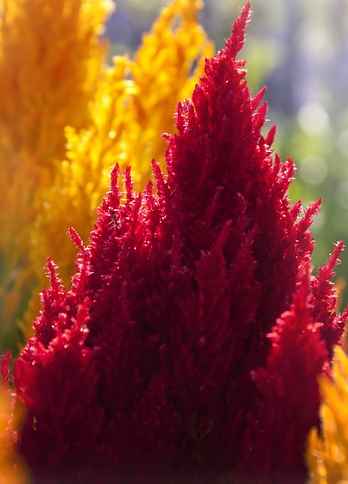
Dragon’s Breath Plant
The ‘Dragon’s Breath’ celosia has extra-large bushy red flower spikes that give the appearance of flames emerging from the leafy green foliage. Dragon’s Breath has a long blooming time and grows exceptionally well in garden landscapes, containers, and flower beds.
Celosia ‘Spicata’ (Celosia argentea var. spicata)
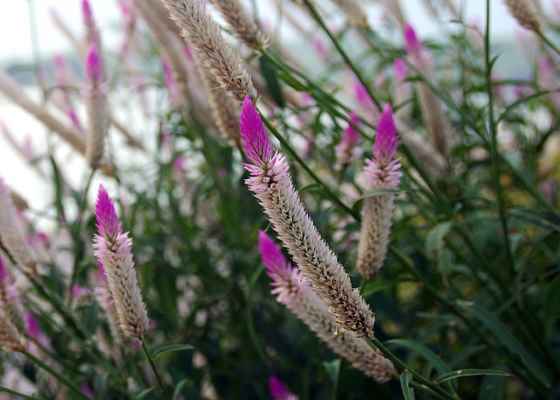
Celosia argentea var. spicata
Cultivars of Celosia spicata plants are distinguished by their flower spikes growing on the end of long stems. The celosia ‘Spicata’ flowers are small cylindrical clusters of hundreds of colorful flowers that resemble a hot poker. The multi-colored flowering spikes grow to 3” (7.5 cm) long.
Celosia Cristata (Celosia argentea var. cristata)
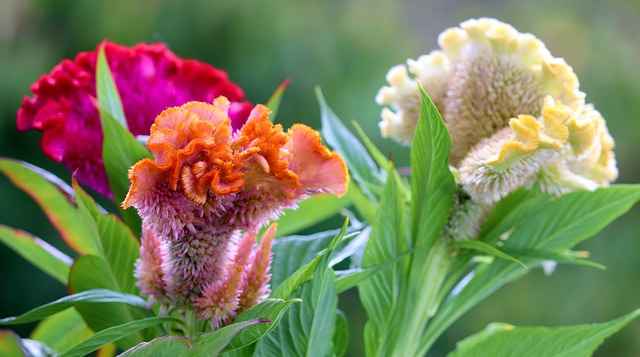
Celosia argentea var. cristata
The Celosia cristata is the most unusual of the celosia flowers, with plumage creating a wavy flower structure. The large crested flowers grow in colors such as mauve, magenta, burgundy, pink, yellow, and orange.
Related articles:
